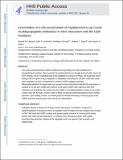Examination of a Structural Model of Peptidomimicry by Cyclic Acyldepsipeptide Antibiotics in Their Interaction with the ClpP Peptidase
Author(s)
Carney, Daniel W.; Scruse, Anthony C.; Sello, Jason K.; Schmitz, Karl Robert; Sauer, Robert T.
DownloadExamination of a Structural.pdf (601.9Kb)
OPEN_ACCESS_POLICY
Open Access Policy
Creative Commons Attribution-Noncommercial-Share Alike
Terms of use
Metadata
Show full item recordAbstract
The cyclic acyldepsipeptide (ADEP) antibiotics act by binding the ClpP peptidase and dysregulating its activity. Their exocyclic N-acylphenylalanine is thought to structurally mimic the ClpP-binding, (I/L)GF tripeptide loop of the peptidase's accessory ATPases. We found that ADEP analogues with exocyclic N-acyl tripeptides or dipeptides resembling the (I/L)GF motif were weak ClpP activators and had no bioactivity. In contrast, ADEP analogues possessing difluorophenylalanine N-capped with methyl-branched acyl groups—like the side chains of residues in the (I/L)GF motifs—were superior to the parent ADEP with respect to both ClpP activation and bioactivity. We contend that the ADEP's N-acylphenylalanine moiety is not simply a stand-in for the ATPases' (I/L)GF motif; it likely has physicochemical properties that are better suited for ClpP binding. Further, our finding that the methyl-branching on the acyl group of the ADEPs improves activity opens new avenues for optimization.
Date issued
2015-07Department
Massachusetts Institute of Technology. Department of BiologyJournal
ChemBioChem
Publisher
Wiley Blackwell
Citation
Carney, Daniel W. et al. “Examination of a Structural Model of Peptidomimicry by Cyclic Acyldepsipeptide Antibiotics in Their Interaction with the ClpP Peptidase.” ChemBioChem 16.13 (2015): 1875–1879.
Version: Author's final manuscript
ISSN
1439-4227
1439-7633